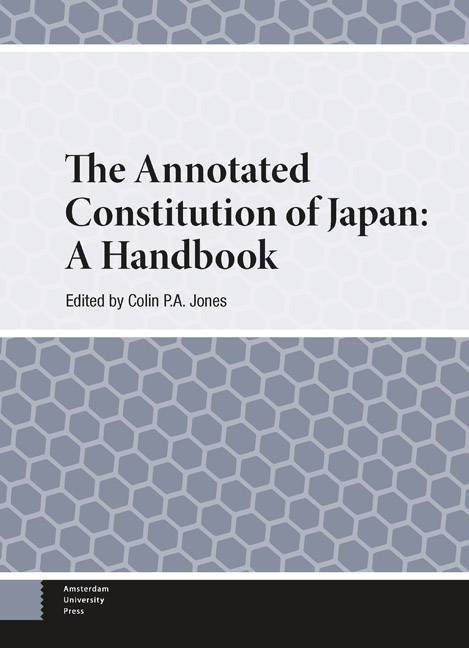Book contents
- Frontmatter
- Dedication
- Contents
- Contributors
- Preface
- Acknowledgements
- Introduction: Historical Overview
- The Preamble
- 1 Chapter I: The Emperor (Articles 1–8)
- 2 Chapter II: Renunciation of War (Article 9)
- 3 Chapter III: Rights and Duties of the People (Articles 10–40)
- 4 Chapter IV: The Diet (Articles 41–64)
- 5 Chapter V: The Cabinet (Articles 65–75)
- 6 Chapter VI: The Judiciary (Articles 76–82)
- 7 Chapter VII: Finance (Articles 83–91)
- 8 Chapter VIII: Local Self Government (Articles 92–95)
- 9 Chapter IX: Amendments (Article 96)
- 10 Chapter X: Supreme Law (Articles 97–99)
- 11 Chapter XI: Supplementary Provisions (Articles 100–103)
- Appendix 1 Constitution of the Empire of Japan (Japanese)
- Appendix 2 Constitution of the Empire of Japan (English translation)
- Appendix 3 The Potsdam Declaration
- Appendix 4 Instrument of Surrender
- Appendix 5 The “MacArthur Notes”
- Appendix 6 The GHQ Draft
- Appendix 7 The Constitution of Japan (Japanese)
- Appendix 8 The Treaty of San Francisco
- Bibliography
- Index
- Index of Articles of the Constitution of Japan
6 - Chapter VI: The Judiciary (Articles 76–82)
Published online by Cambridge University Press: 13 February 2024
- Frontmatter
- Dedication
- Contents
- Contributors
- Preface
- Acknowledgements
- Introduction: Historical Overview
- The Preamble
- 1 Chapter I: The Emperor (Articles 1–8)
- 2 Chapter II: Renunciation of War (Article 9)
- 3 Chapter III: Rights and Duties of the People (Articles 10–40)
- 4 Chapter IV: The Diet (Articles 41–64)
- 5 Chapter V: The Cabinet (Articles 65–75)
- 6 Chapter VI: The Judiciary (Articles 76–82)
- 7 Chapter VII: Finance (Articles 83–91)
- 8 Chapter VIII: Local Self Government (Articles 92–95)
- 9 Chapter IX: Amendments (Article 96)
- 10 Chapter X: Supreme Law (Articles 97–99)
- 11 Chapter XI: Supplementary Provisions (Articles 100–103)
- Appendix 1 Constitution of the Empire of Japan (Japanese)
- Appendix 2 Constitution of the Empire of Japan (English translation)
- Appendix 3 The Potsdam Declaration
- Appendix 4 Instrument of Surrender
- Appendix 5 The “MacArthur Notes”
- Appendix 6 The GHQ Draft
- Appendix 7 The Constitution of Japan (Japanese)
- Appendix 8 The Treaty of San Francisco
- Bibliography
- Index
- Index of Articles of the Constitution of Japan
Summary
Historical overview
Though civil and criminal adjudicatory processes had operated in Japan for centuries, the roots of the present-day court system in Japan can be traced back to 1872, when an ordinance from the newly-established Ministry of Justice created a national court structure in the country. Other early Meiji innovations, such as the establishment in 1875 of a Great Court of Cassation (Daishin’in) based on the French Cassation, contributed to the shaping of the court system. With the passage in 1896 of the Court Organization Law, heavily influenced by German models, the Japanese judicial system gained its modern features at the same time as the other features of government under the Meiji constitutional system took shape.
In the Meiji Constitution, Chapter V was devoted to “The Judicature,” while in the current constitution, Chapter VI deals with “The Judiciary.” The Japanese term (shihō) used is the same in both texts, meaning the difference is primarily one of changing the English to match a more contemporary (and possibly American) reading. Under the Meiji system the Ministry of Justice was named the shihōshō, as it administered the justice system, including the courts. The overlap of the judiciary and the executive was thus a feature of the Meiji system.
As discussed later in this chapter, the highly bureaucratic organization of the Japanese judiciary born under the Meiji reforms may still be observed in contemporary Japan, and continued close ties and cooperation between the judiciary and the Ministry of Justice is a key element in understanding how the Japanese judicial system operates today.
Consistent with the idea of a state centered around the emperor which was the foundation of the Meiji Constitution, and the attendant rejection of any fundamental separation of powers, the Judiciary was not a fully autonomous governmental organ. This is clear from Article 57, which reads “The Judicature shall be exercised by the Courts of Law according to law in the name of the Emperor.” Moreover, perhaps more importantly for practical purposes, judges were subject to the administrative authority of the Ministry of Justice.
- Type
- Chapter
- Information
- The Annotated Constitution of JapanA Handbook, pp. 248 - 275Publisher: Amsterdam University PressPrint publication year: 2023



